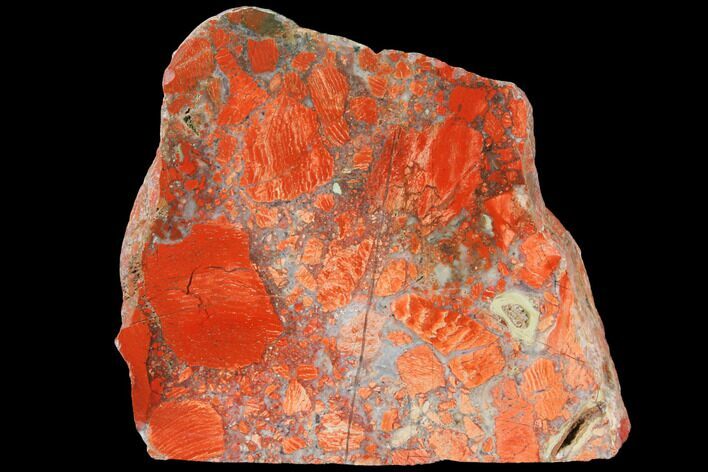This Specimen has been sold.
6.9" Free-Standing, Polished Brecciated Snakeskin Jasper - Australia
This is a vibrantly colored section of brecciated snakeskin jasper from Western Australia. It has been cut flat on one side and polished to a mirror like finish, revealing some very interesting banded patterns. One edge has been cut for presentation purposes and the rest of the specimen has been left in its rough state.
It formed as seams of jaspilite in a banded iron formation called the "Weeli Wooli Formation" which is about 2.5 billion years old.
The term "brecciated" is directly related to fragmented and cemented mineralizations, such as this snakeskin jasper. Following the breaking of this rock, ground water containing silica assisted in the natural cementing process of the fragmented jasper, resulting in this beautiful mineral association.
It formed as seams of jaspilite in a banded iron formation called the "Weeli Wooli Formation" which is about 2.5 billion years old.
The term "brecciated" is directly related to fragmented and cemented mineralizations, such as this snakeskin jasper. Following the breaking of this rock, ground water containing silica assisted in the natural cementing process of the fragmented jasper, resulting in this beautiful mineral association.
About Jasper
Jasper is a term that can be applied to an opaque variety of chalcedony. The opaqueness is due to a higher concentration of impurities mixed with silica/quartz compared to other varieties of silica, such as quartz or agates. Like agate it may form in a wide variety of colors, and is often multi-colored. In most cases, jasper forms when silica-rich fluids permeate throughout a soft sediment or volcanic debris deposit. The fluids then crystallize around the particles/impurities, resulting in a cementation process. Most often, the impurities present determine the coloration of the deposit following solidification, but other factors can play a role in the color of what is now considered a jasper.
Jasper is a term that can be applied to an opaque variety of chalcedony. The opaqueness is due to a higher concentration of impurities mixed with silica/quartz compared to other varieties of silica, such as quartz or agates. Like agate it may form in a wide variety of colors, and is often multi-colored. In most cases, jasper forms when silica-rich fluids permeate throughout a soft sediment or volcanic debris deposit. The fluids then crystallize around the particles/impurities, resulting in a cementation process. Most often, the impurities present determine the coloration of the deposit following solidification, but other factors can play a role in the color of what is now considered a jasper.
SPECIES
Quartz var. Jasper
LOCATION
Turee Creek Cattle Station, Pilbara Region, Western Australia
FORMATION
Weeli Wooli Formation
SIZE
6.9 x 5.8", up to 2.5" thick
CATEGORY
SUB CATEGORY
ITEM
#133028
 Reviews
Reviews














